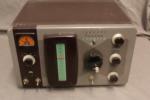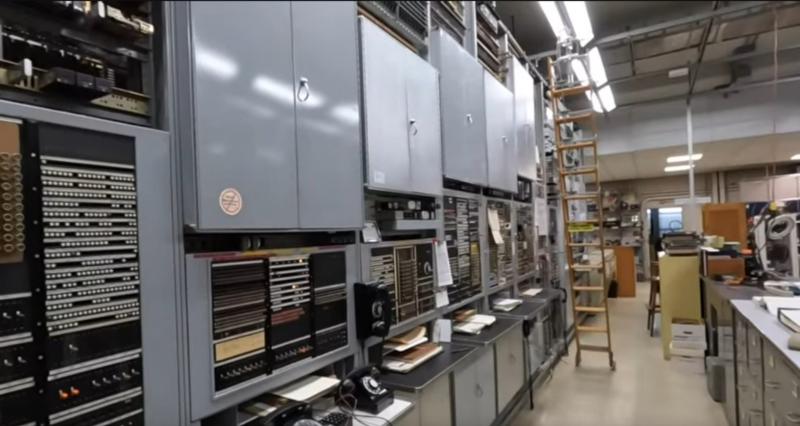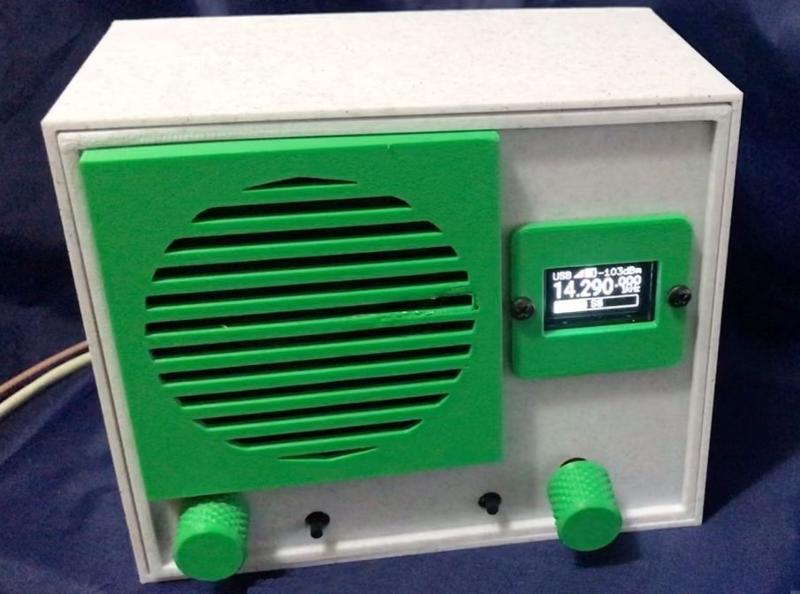LM386 audio amplifier makes a really good regenerative receiver!
Demo of simple AM BC receiver breadboard
Posted By: Robert Nickels (ranickels)
Posted on 02/25/2019
|
I'm nuts for minimalist solutions...as the wise old engineers would say "It's easy to make a circuit work if there's no limit on parts or cost". Early television mogul Earl "Mad Man" Muntz fumed about "overengineering" and gained notoriety by snipping out components until the picture or sound stopped working, then told his engineer "Well I guess you have to put that part back In". But to my way of thinking, minimalist designs aren't just corner-cutting, and often take advantage of unique capabilities of components or circuits to accomplish a task in an an elegant way. That's why I was instantly intrigued by a thread on Radioboard about using an LM386 audio amplifier IC as a regenerative AM broadcast band radio. Here's a link to that site and I suggest reading it to the end as multiple improved circuits and tradeoffs are discussed: http://theradioboard.com/rb/viewtopic.php?f=4&t=6413&sid=07d79a1d8c3cb46ad619ac2ba35b7502 The LM386 was invented by Ernie Leroy Long at Motorola in 1969. It was originally for part of a fuel injection system for a Ford vehicle and integrates 8 transistors in an 8 pin DIP package that runs from 9 to 12 volts DC. It has become ubiqitous for low-cost audio amplification in millions of devices from toys to QRP rigs. Occasionally I've seen deviations from the reference design in the databooks but credit goes to user "Selenium" at Radioboard for being the first to figure out how to introduce regeneration and apply it as a complete AM radio receiver, not just the audio section of one. Interestingly this wasn't the first application of an audio IC as a regenerative detector - the discussion above included a datasheet for the 1956 vintage Westinghouse WC183 hearing aid amplifier that shows one. It seems like this idea has been a long time coming! I think this simple circuit can be the basis of a number of interesting projects - it sure doesn't take much to make one and try it out. With a high-Q coils many signals should be audible with a minimal antenna (or none) in urban areas. Current consumption is low enough that battery operation is feasible and loudspeaker volume always beats having to wear a pair of ear-squeezers! The recenerative circuit was invented by Major Edwin Armstong in 1912 while still an undergraduate at Columbia University and patented in 1914. While he later went on to develop the superheterodyne receiver and FM, in my view the elegant simplicity of regeneration is his crowning acheivement. Here is the schematic I used - see the link above for other variations and feel free to experiment:
|
Latest Articles

Technical
Posted: 01/29/2025
Comments: 0 |
Pico Rx performance - Excellent performance on 630m WSPR
The Simple Pico Rx is my minimalist implementation of Jonathan Dawson's "Pico Rx" at 101things: https://github.com/dawsonjon/PicoRX In this basic form the receiver consists of a Quadrature Sampling Detector (QSD aka Tayloe) and the Pico2 MCU which handles all DSP functions. There are NO front-end filters, the only bandwidth limitation comes from the tracking filter... READ MORE |

Crystal Replacement
Posted: 08/226/2024
Comments: 0 |
Making SMT "no lead" parts easier to use
SMT is the future - but how can we actually use parts without leads? ... READ MORE |
|
Crystal Replacement
Posted: 02/38/2024
Comments: 0 |
How good can a crummy receiver be?
Hundreds of different simple SDR receivers have been designed around Dan Tayloe's Quadrature Sampling Detector or QSD. Mine add nothing to the state of the art, and in fact subtract things, as I like minimalist solutions and the QSD is right in that sweet spot. Following the evolution of Tayloe's design I delete the resistors in series with the sample lines for inst... READ MORE |

Technical
Posted: 02/37/2024
Comments: 0 |
What's in a number (3253)?
The FST3253 dual four-to-one mux/demux IC has long been used as a "Tayloe Detector" or QSD (and QSE) in low-cost SDRs. They provide incredible performance for such a simple circuit, converting RF to baseband IQ with low loss and the ultimate in simplicity. Unfortunately the original FST3253 part has become obsolete and while substitutes are available, this is where the... READ MORE |

Vintage Ham Radio
Posted: 02/32/2024
Comments: 0 |
The Stancor 10P Transmitter
There weren't really many commercial transmitters in the 1930s as most hams built their own. But many of the ones that were offered came from the transformer companies who had two chances to profit. First, from those who would buy the kit, and two, from those would would see it in the (free) booklets the companies provided to their distributors who would then sell the iron to ham... READ MORE |

Vintage Ham Radio
Posted: 12/355/2023
Comments: 0 |
The Care and Feeding of the EF Johnson Courier amplifier
The EF Johnson "Courier" is a grid-driven amplifier using two 811A tubes. Switching is provided for operating in either class C for CW or as a class B linear amplifier for AM or SSB. Rated power is 500 watts input for CW, 500 watts PEP input for SSB, and 200 watts input for double-sideband AM with carrier. Since all amateur power levels were meas... READ MORE |

Historic
Posted: 11/329/2023
Comments: 0 |
TV Duplexer
Some things are interesting, even if totally useless nowadays. Such is the case with the Philco 426-3034 Crossover Kit for UHF TV. What the heck is that? Well, back in the late 50s, UHF television stations operating on channels 14-83 started to appear in many areas of the US where viewers had a VHF-only TV antenna, and in many cases an externa UHF converter was... READ MORE |

Crystal Replacement
Posted: 11/327/2023
Comments: 0 |
Replacing failed crystals
For decades, quartz crystals were used everywhere a stable frequency source was needed, even in some applications that depended on overtone (harmonic) behavior into the VHF range. These crystals were less stable and more dependent on circuit parameters that fundamental types and thus more problematic. Such was the case with the 94 MHz crystal in the 2 meter converter ... READ MORE |

Historic
Posted: 11/315/2023
Comments: 0 |
My Own Ham Radio Story by W9RAN
Everyone has a story of how they got involved in ham radio - this is mine. It started much earlier, including receiving a Knight Kit Span Master shortwave radio for Christmas in about 1963, at age 12. I'll never forget the night my dad and I finished building it and I wanted to try it out. It came with a 50 ft. antenna which was still coiled up - but ... READ MORE |

Technical
Posted: 09/267/2023
Comments: 0 |
Hot to simulate vacuum tubes in LTSpice
LTSice is a powerful simulation tool that is provided free by Linear Technology Corp. It comes with a complete library of passive and common analog solid-state components but if you want to use it to simulate vacuum tubes, it doesen't work as-is. Even though triode and pentode symbols can be found in the "Misc" folder, they are just schematic symbols and... READ MORE |
Latest News

Comments: 0
"Flying the Beams" - a terrific website on radio navigation
Those interested in radio navigation, specifically the A-N, or Low Frequency Radio Range, will enjoy spending time exploring this great websitewww.flyingthebeams.comThe creator, Doug Davis, has done an exceptionally good job of explaining not only the Low Frequency Radio Range (LFR) but the evolution of airborne navigation to the present day, with many illustrations and photos that I h... READ MORE
Comments: 0
Bob Heil K9EID SK
Posted 3/1/24 at Heil Sound Facebook page:Our beloved founder, Dr. Bob Heil, K9EID, is now a Silent Key. Bob fought a valiant, year-long battle with cancer, and passed peacefully surrounded by his family. Bob’s lifelong passion for amateur radio was clear to everyone involved in the hobby. Everything Bob did for the betterment and growth of amateur radio – from his instructional handbo... READ MORE
Comments: 0
Joe Munson WA4VAG (SK)
With great sadness we note the passing of a veteran, long-time ham, and one of the most interesting people I've ever met, Joe Munson WA4VAG. Joe's love for military radios began when his life depended on one - the famous "Prick 74" that he toted around Viet Nam (and certain other countries where the US miltary officially never was) and expanded to include workin... READ MORE
Comments: 0
Quantum Spectrum - a DSP add-on for low-end SDRs
As one who has been playing with small inexpensive SDRs since the days of the Softrock, I've been amazed by how well the simple yet very effective Quadrature Sampling Detector aka "Tayloe Detector" (named after it's inventor Dan Tayloe) actually works. Using calibrated equipment I've measured the Minimum Detectable Signal (MDS) at -122dBm using the same 3dB ... READ MORE
Comments: 0
WANTED: Bendix 3206
Power Supply/Mod/IF unit This is an odd and unusual piece of gear, it's got IF cans one one end and a dynamotor on the other! It's the back half of the receiver plus power supply and modulator for the Bendix 3801 HF system that was used on aircraft before the switch to VHF. The functions were split between the two units to save panel space. Click the image to e... READ MORE
Comments: 0
New droplet-based electricity generator
A drop of water lights up 100 small LED bulbs A team of engineers has figured out how to take a single drop of rain and use it to generate a powerful flash of electricity. The City University of Hong Kong researchers behind the device, which they're calling a droplet-based electricity generator (DEG), say that a single rain droplet can briefly generate 140 volts. Their findings were published in the latest issue of the highly prestigious ... READ MORE
Comments: 0
Russian soldiers uses Chinese portable radios
Baofung UV-82HP - unencrypted The Russian military has used civilian mobile phones and radios for their communications, including Chinese-made civilian handheld radio, during the ongoing Kremlin’s invasion of Ukraine.According to Defence-Blog.com, the Russian military is using the BaoFeng UV-82HP radios for communication within the frontline units currently stationed in Ukraine.The Ukrainian military manages to sei... READ MORE
Comments: 0
Amateur radio transmittting suspended in Ukraine
part of a 30 day emergency order Full information hereSee Feb. 27 update HERE.Some webSDRs now blocking the spectrum around UVB-76 to prevent monitoring of it. ... READ MORE
Comments: 0
Local IL Ham featured in newspaper article
W9JC, Freeport IL A former Honeywell work colleague and local ham friend was recently featured in a front-page story in the Freeport Journal StandardJohn does a nice job of explaining the relevance of Ham Radio in the 21st century:“Think about that little cell phone you carry around which is only a radio,” he said. “That all happened in the last 100 years. That’s one lifespan for many people... READ MORE
Comments: 0
This 22-year-old builds chips in his parents’ garage
the crystal set of the 21st century? In August, chipmaker Intel evealed new details about its plan to build a “mega-fab” on US soil, a $100 billion factory where 10,000 workers will make a new generation of powerful processors studded with billions of transistors. The same month, 22-year-old Sam Zeloof announced his own semiconductor milestone. It was achieved alone in his family’s New Jersey garage, about 30 miles ... READ MORELatest News

WANTED: Bendix 3206
Power Supply/Mod/IF unit
New droplet-based electricity generator
A drop of water lights up 100 small LED bulbs
Russian soldiers uses Chinese portable radios
Baofung UV-82HP - unencrypted
Amateur radio transmittting suspended in Ukraine
part of a 30 day emergency order
Local IL Ham featured in newspaper article
W9JC, Freeport IL
This 22-year-old builds chips in his parents’ garage
the crystal set of the 21st century?Latest Videos

Quantum Spectrum - a DSP option for SDRs
and maybe ALL radios (someday)
At the Connections Museum in Seattle
the insane telephone technology that led to today's computers
The Story of Heil Sound
Rock and Roll Hall of Fame presentationLatest Links

|
Paul Stoffregen is the creator of the Teensy microcomputer and related products and has authored a vast amount of exceptionally good and useful public domain software to go with it. As the old saying goes "no good deed goes unpunished" and in the course of answering customer and would-be customer questions, Paul has written over 18,000 replies. From that he's ... READ MORE
- Robert Nickels (ranickels), 12/10/2018
|

|
The VERSA-TR kit designed by RAN Technology Inc. is available from our friends at Hayseed Hamfest. Please direct all order-related questions to them at https://hayseedhamfest.com/pages/contact-us... READ MORE
- Robert Nickels (ranickels), 11/11/2018
|








